
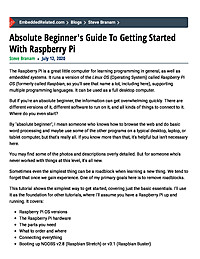
Absolute Beginner's Guide To Getting Started With Raspberry Pi
The Raspberry Pi is a great little computer for learning programming in general, as well as embedded systems. It runs a version of the Linux OS (Operating System) called Raspberry Pi OS (formerly called Raspbian, so you'll see that name a lot,...

Make Hardware Great Again
By now you're aware of the collective angst in the US about 5G. Why is the US not a leader in 5G ? Could that also happen -- indeed, is it happening -- in AI ? If we lead in other areas, why not 5G ? What makes it so hard ? This...
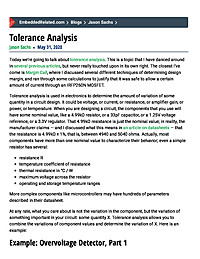
Tolerance Analysis
Today we’re going to talk about tolerance analysis. This is a topic that I have danced around in several previous articles, but never really touched upon in its own right. The closest I’ve come is Margin Call, where I discussed...

Scorchers, Part 2: Unknown Bugs and Popcorn
This is a short article about diminishing returns in the context of software releases. Those of you who have been working professionally on software or firmware have probably faced this dilemma before. The scrum masters of the world will...
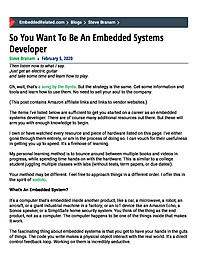
So You Want To Be An Embedded Systems Developer
Then listen now to what I say. Just get an electric guitar and take some time and learn how to play. Oh, wait, that's a song by the Byrds. But the strategy is the same. Get some information and tools and learn how to use them. No need to...

Embedded Programming Video Course Shows How OOP Works Under the Hood
If you'd like to understand how Object-Oriented Programming (OOP) really works under the hood, here is a free video course for you: OOP part-1: Encapsulation: This first lesson on Object-Oriented Programming (OOP) introduces the concept of...
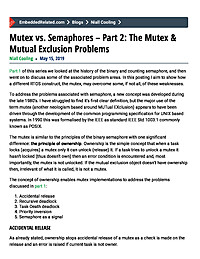
Mutex vs. Semaphores – Part 2: The Mutex & Mutual Exclusion Problems
Part 1 of this series we looked at the history of the binary and counting semaphore, and then went on to discuss some of the associated problem areas. In this posting I aim to show how a different RTOS construct, the mutex, may overcome some, if...
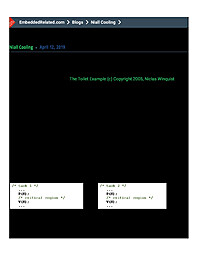
Mutex vs. Semaphore - Part 1
It never ceases to amaze me how often I see postings in forums asking the difference between a semaphore and a mutex. Probably what baffles me more is that over 90% of the time the responses given are either incorrect or missing the key...
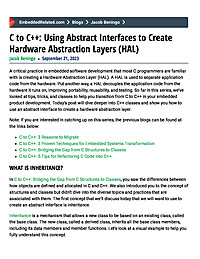
C to C++: Using Abstract Interfaces to Create Hardware Abstraction Layers (HAL)
In C to C++, we've been exploring how to transition from a C developer to a C++ developer when working in embedded system. In this post, we will explore how to leverage classes to create hardware abstraction layers (HAL). You'll learn about the various inheritance mechanisms, what an virtual function is, and how to create an abstract class.
Who needs source code?
Many developers feel that the supplying source code is essential for licensed software components. There are other perspectives, including the possibility of it being an actual disadvantage. Even the definition of source code has some vagueness.
New book on Elliptic Curve Cryptography
New book on Elliptic Curve Cryptography now online. Deep discount for early purchase. Will really appreciate comments on how to improve the book because physical printing won't happen for a few more months. Check it out here: http://mng.bz/D9NA
Three more things you need to know when transitioning from MCUs to FPGAs
Take a look at three more important difference between FPGAs and MCUs: "code reuse" vs templating, metastability and blocking vs. non-blocking operations.
Getting Started With Zephyr: Devicetree Bndings
This blog post shines some light on how devicetrees are used in The Zephyr Project. Specifically, we understand the mechanisms that enable us to use nodes in the devicetree in the C source files. We use a sample provided in the Zephyr repository itself and work our way through portions of the Zephyr codebase to get insight into the mechanisms that make this possible.
From Embedded Software Engineer to Musician
In his first blog post on EmbeddedRelated, Jean Labrosse, the author of the uC/OS series and founder of Micrium, discusses his transition from an embedded software engineer to a musician.
Quaternions and the spatial rotations in motion enabled wearable devices. Exploiting the potential of smart IMUs attitude estimation.
Have you always wondered what a quaternion is? this is your post. Attitude or spatial orientation analysis is a powerful element in wearable devices (and many other systems). Commercially available sensors can provide this information out-of-the-box without requiring complex additional implementation of sensor fusion algorithms. Since these are already on-chip solutions devices can serve as a way to explore and analyze motion in several use cases. Mathematical analysis for processing quaternion is presented along with a brief introduction to them, Although they are not really easy to visualise, a couple fairly simple examples are provided which may allow you to gain some intuition on what's the logic behind them.
Getting Started With Zephyr: Kconfig
In this blog post, we briefly look at Kconfig, one of the core pieces of the Zephyr infrastructure. Kconfig allows embedded software developers to turn specific subsystems on or off within Zephyr efficiently and control their behavior. We also learn how we can practically use Kconfig to control the features of our application using the two most common mechanisms.




















